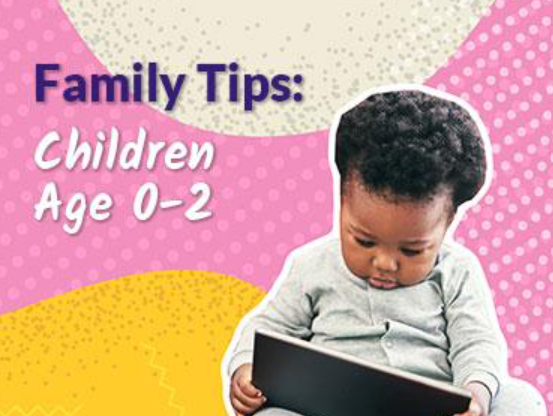
SEPTEMBER 2024
Neuroscience in the Nursery
Screen time has been a trending topic lately, on the back of a movement to ban smartphones from classrooms where they’ve been gaining the upper hand in the battle for students’ attention. Even if your child is a toddler (or younger), you’ve likely had questions about screen time yourself since, chances are, your child already has logged some impressive screen time experience. And if you’re like most parents, you’re hopeful that all this screen time is educational – or at least not harmful, because you’re immensely grateful for the break it gives you. We have thoughts.
Today’s Topic: Screen Time and Young Children – Much Still to Learn

Image by freepik
Questions about the developmental impact of screen time have sparked an enormous amount of research since the advent of TV. A search for articles on screen time in PubMed®, the NIH’s database of peer-reviewed biomedical and life sciences research, produces nearly 40,000 articles, many of those produced in the wake of the pandemic, reflecting concern over the increased time children of all ages were spending on digital screens, particularly during lockdowns.
Coming from a neuroscience perspective, we have a few observations about the existing body of work on screen time, specifically as it relates to young children, that we want to bring to your attention:
1) Researchers are playing catch-up. Much of the research is dated, especially that contained in the systematic and scoping reviews that distill findings from studies spanning one or more decades. This would be less of an issue if the nature of childhood screen time had remained static over the years. However, screen content, devices, and behavior have changed considerably over time, including the use of tablets and smartphones by very young kids. We don’t yet know if this kind of digital screen use – in the high daily “dosages” that are becoming a norm even at very early ages – differs measurably (positively or negatively) from TV screen viewing. As the UK Royal College of Paediatrics and Child Health says, applying current research to develop guidelines “to apply to today’s children and young people [is difficult] as their use of screens is evolving so rapidly.1
2) We are short on longitudinal research addressing how children today engage with digital screens. The preponderance of existing research is cross-sectional, meaning it compares outcomes in children and adolescents at a specific point in time. While helpful in identifying associations, cross-sectional studies lack the power of longitudinal research, which tracks changes over time to determine causality. Indeed, one big unanswered question is what will be different in the brains of kids born today due to the prolonged period that they will spend with digital devices. Young brains are highly plastic, that is, very susceptible to change from the experiences to which they’re exposed. Today, many two-and-unders are engaging with mobile devices; by the time they start school, they will have had years of digital exposure. Their parents would benefit from a scientifically informed understanding of how prolonged early childhood experience with digital screen time impacts – for better or worse – structural brain development. Unfortunately, longitudinal studies examining the cognitive, social, and physical impacts of the extensive and persistent screen time engaged in by today’s young children have yet to be completed (and in many cases even initiated).
3) Screen time is a very slippery slope . . . that only gets steeper as kids age. If you are having trouble limiting your little one’s time with digital devices (research suggests that many parents find it challenging to wrest their young kids away from a digital screen), wait until they hit thirteen.
Experts Say. . .
Screen time recommendations from pediatric organizations are pretty consistent; the ones below are widely supported and, with the caveats noted, seem generally sensible. That said, as a whole, they’re not all that satisfying, so we highly recommend staying abreast of the topic. As research proceeds, we expect more specific guidance on managing your child’s digital screen time to best support their development.
- Keep content developmentally appropriate. There’s not a lot of specificity to this recommendation except that the content should be age-appropriate (with that determination left up to parents) and non-violent. Video chatting is often noted as a preferred format (although that’s never as good as IRL talk). From a neuroscience perspective, we’d like to see much more attention given to what constitutes suitable content. Studies on older children using apps in constrained circumstances show both positive and negative results – and we certainly need more conclusive work in this area. But there’s still not a lot of research on the impact of app use by children under five. That’s a miss given the extensive brain development that children under five are experiencing and the potential risk to that development posed by, say, playing games whose characteristics (time limits, scores/levels, rewards and penalties) produce elevated cortisol levels on a persistent basis or impair a child’s ability to self-regulate. Is there a long-term negative impact from regular exposure of toddlers to these games? We don’t know, but we hope that further research will give parents greater clarity than they have now.
- Co-view whenever possible. The idea here is that your child will be able to benefit from the adult-child interaction that is so important to language development, social interaction, emotional regulation, etc. We recognize that co-viewing is not that easy when your child is on a smartphone or a tablet, and it certainly doesn’t replace the multisensory experience you get reading a physical book with a child, but still, try.
- Do not let digital become part of a nighttime routine. Maybe blue light emanating from digital screens is disruptive to sleep, perhaps not (the findings keep changing). Still, a young child playing a game before bed is probably not developing the alpha waves characteristic of a drowsy brain (and may be setting their path to a teen hood of scrolling through social media till the wee hours each night).
- Limit your child’s exposure. Here, we will be maddeningly vague because institutional recommendations are all over the place, and we don’t have a specific research-backed recommendation of our own to make. Be aware that by default, any screen time stands in the place of some other activity, and you need to be the one who questions when and where that is okay. We will not deny that some screen-based content has been associated with developmental (e.g., fine motor skills, problem-solving) and other cognitive benefits (e.g., ability to relax or focus) in small studies. But we know your child needs healthy doses of physical activity, social interaction, and sensory engagement beyond a touch screen to develop efficient brain networks in early childhood. It’s up to you to be on top of what activity that screen time is replacing, and if you find your child has trouble detaching from a screen to engage in any of those other activities, that is a sign that whatever limits you’ve been imposing may not be enough.
- Watch your own screen time. The children of a RAPT Ventures team member have an extensive photo album (digital, of course) of their mom on her smartphone during family vacations. Though the kids seemed to have survived her distraction and very poor role modeling, she is very thankful she wasn’t also a gamer – otherwise, who knows how they would have turned out? The point is obvious but it bears repeating because it is so easy to succumb to the lure of your phone if you don’t remind yourself of its consequences for your child. Especially at the youngest ages, children need all the positive parental interaction they can get, but you’re not likely to give them everything you can if you’re on your phone. Think about the “serve and return” conversations between adult and child so critical to language development. How will you maintain your part in initiating and amplifying that flow (“Charley, what is this? What is that?), including the eye contact which is such an essential component of those exchanges, if you’re glued to a screen? You won’t, so if you find yourself itching to pull out your phone when you could be talking with your child, check yourself (and make sure this message gets through to everyone in a position of caregiving for your child).
Where Research on Screen Time and Young Children is Heading
Will our understanding of the impact of screen time change as it becomes almost entirely digital?
Almost certainly, yes. Here are just a few areas where researchers are turning their focus:
- Impact on joint attention. One concern with smartphone and tablet play is that it generally occurs independently, replacing other forms of play that foster more significant adult-child interaction. Given findings that children who engaged in higher levels of tablet play had poorer language outcomes, Seattle-based researchers decided to investigate whether the cause might be a decrease in joint attention (when a caregiver and child are paying attention to the same thing, as in reading a book together or when one calls the other to attend to something). Indeed, they found that playing a tablet game was associated with fewer responses to joint attention prompts (Chloe, look here!) and greater reluctance to give up the game, especially among male toddlers. Their conclusion? Early experience with tablet games may be detrimental to the social-communicative interactions that support language development, particularly if they reduce or replace real toy play, parent-child activities, or peer play.2
- Physical vs. digital play. In the same study, the Seattle researchers describe some critical developmental differences between physical and digital play. Physical toys tend to involve more multidirectional motor coordination, symbolic play (such as pretending a block is a car), and endogenous (self-directed) attention on the child’s part. In contrast, digital games are more likely to capture and direct a child’s focus (exogenous attention) and that capture may hinder the development of a child’s ability to focus and make independent decisions. The researchers note that the real-world consequences of a potentially large-scale shift from physical to digital play are yet to be understood.3
- The YouTube effect. YouTube Kids is a godsend for many parents who find it an easy source of that “age-appropriate content,” thoughtfully moderated by the YouTube algorithm that gives their child more of what they like. In Korea, where 94% of elementary school kids have smartphones and concern about digital addiction is a pressing societal issue, researchers have been focusing on the potential risks of early YouTube use. They found that the earlier the age at which YouTube use started, the higher the subsequent usage frequency – raising the specter that, as some studies have found with smartphones, early exposure might heighten the risk for later addiction. Additionally, the combination of young starting age and higher relative usage was “significantly associated with increased emotional/behavioral problems” related in part to the way children consume YouTube on smartphones, i.e., where their preference for short-form content creates more frequent but shorter usage patterns associated with greater distractibility, lower patience, and self-control.4
Parenting Takeaway
Digital screen time is a fact of life, but with so much yet to be learned, our roots in developmental cognitive neuroscience cause us to err on the side of caution and encourage you to keep your kids away from screens for as long and as much as possible. This advice is especially directed at those with young children where we fear digital screen time could be meaningfully replacing the multi-sensory, human engagement that has proven to be so important to setting up brains.
Sources:
1Royal College of Paediatrics and Child Health. (2019). The health impacts of screen time: A guide for clinicians and parents. Royal College of Paediatrics and Child Health.
2Webb, S. J., Howard, W., Garrison, M., Corrigan, S., Quinata, S., Taylor, L., & Christakis, D. A. (2024). Mobile Media Content Exposure and Toddlers’ Responses to Attention Prompts and Behavioral Requests. JAMA Network Open, 7(7), e2418492-e2418492.
3Ibid.
4Kim, D., Lee, S., Kim, H., & Shin, Y. (2024). From temperament to YouTube: exploring the link between childhood temperament, YouTube usage patterns, and emotional/behavioral problems among children. BMC public health, 24(1), 1547. https://doi.org/10.1186/s12889-024-19011-w
A Source for More #1
To give you a feel for how researchers are thinking about these issues, take a look at this paper reporting the results of a workshop which brought together a group of academics from fields such as psychiatry, neuroscience, and pediatrics to discuss the various ways digital media might affect neurodevelopment. The paper is a (mostly) easy read and is valuable both as a source of existing research on different aspects of this issue and as a summary of the many questions these academics believe deserve further exploration.
A Source for More #2
If you want help slow-rolling your baby’s exposure to screen time, nonprofit Common Sense Media has a short set of rules, in English and Spanish, to help you keep control (also check out their main site, commonsensemedia.org for their extensive reviews and recommendations on media, including apps for children).
RAPTbaby Recommendation: PubMed®
If you’re the type that likes to go to the source, this database is for you. Whether you want to know about about the neurodevelopment we’ve been focusing on in these newsletters or are interested in research on some other topic in medicine and life sciences, you’re bound to find something in the nearly 40 million articles cited here. Typing a few words on what you’re looking for in the search engine (fyi, logging in is not required) will take you to a screen with preliminary results which you can then filter by a variety of characteristics such as age of publication, age of research subject, and type of article.
Note: many journals charge for access to one of their articles so you can also filter to be shown articles for which the full text is available for free.


